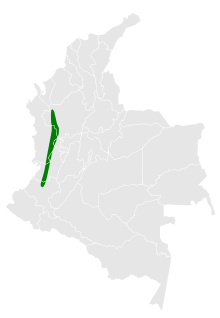| Chami antpitta | |
|---|---|

| |
| Scientific classification | |
| Domain: | Eukaryota |
| Kingdom: | Animalia |
| Phylum: | Chordata |
| Class: | Aves |
| Order: | Passeriformes |
| Family: | Grallariidae |
| Genus: | Grallaria |
| Species complex: | Grallaria rufula complex |
| Species: | G. alvarezi |
| Binomial name | |
| Grallaria alvarezi Cuervo, Cadena, Isler & Chesser, 2020 | |

| |
The Chami antpitta (Grallaria alvarezi) is a species of bird in the family Grallariidae. It is endemic to Colombia.
Taxonomy and systematics
What is now the Chami antpitta was thought to be an undifferentiated population of what was then the rufous antpitta (G. rufula sensu lato). Research published in 2020 showed that it was a distinct species, and another 2020 publication confirmed that it is part of the rufous antpitta species complex of some 15 species. The International Ornithological Committee and the Clements taxonomy recognized the new species in 2021. As of early 2024 BirdLife International's Handbook of the Birds of the World (HBW) had not recognized it.
The common name Chami recognizes the Embera Chamí indigenous community who inhabit the western slopes of Colombian Andes. Nymphargus chami, an endemic Colombian frog, is also named for the Chamí. The specific epithet alvarezi honors the Colombian ornithologist Mauricio Álvarez Rebolledo.
The Chami antpitta is monotypic.
Description
Grallaria antpittas are a "wonderful group of plump and round antbirds whose feathers are often fluffed up...they have stout bills very short tails". The Chami antpitta is about 14.5 to 15 cm (5.7 to 5.9 in) long. The sexes have the same plumage. Adults are almost entirely an intense reddish brown that is deeper on the breast. The center of their belly is a lighter buffy brown with a slight scaly pattern on its lower part. Their vent and outer tail feathers are slightly lighter than their body. Their flight feathers and wing coverts have slightly dusky inner webs. Both sexes have a dark brown iris, a dusky black maxilla, a dusky black mandible with a buffy base and a pale tip, and grayish blue legs and feet.
Distribution and habitat
The Chami antpitta is endemic to the Colombia's Western Andes from Antioquia Department south to northwestern Cauca Department and possibly beyond. Its exact habitat requirements have not been documented. However, it appears to favor the floor and understory of forest that is heavy with moss and epiphytes and has stands of Chusquea bamboo. Most reports are at elevations between 2,350 and 3,650 m (7,700 and 12,000 ft).
The Cauca river separates the Chami antpitta from the closely related Equatorial antpitta (G. saturata).
Behavior
Movement
The Chami antpitta is assumed to be resident throughout its range.
Feeding
The Chami antpitta's diet is not known in detail but includes arthropods, other invertebrates, and earthworms. It forages while running or hopping on the forest floor and stopping to find prey by flipping aside leaf litter and probing the soil.
Breeding
Nothing is known about the Chami antpitta's breeding biology.
|
Songs and calls Listen to the Chami antpitta on xeno-canto |
Vocalization
The Chami antpitta's long song is "a rapid, slightly descending trill of short, low bandwidth notes lasting ~2.5–3.5 ". Its short song is a "quick (⁓0.4–0.5 s) vocalization that begins with a single clear note, followed by a brief pause and then a fast, accelerating trill of 4–5 notes" and has a "stuttering, vaguely purring quality". It apparently sings mostly at dawn and is assumed to do so from a low perch like many other Grallaria antpittas.
Status
The IUCN follows HBW taxonomy, which does not recognize the Chami antpitta, and so has not assessed it.
References
- ^ Gill, Frank; Donsker, David; Rasmussen, Pamela, eds. (August 2024). "Antthrushes, antpittas, gnateaters, tapaculos, crescentchests". IOC World Bird List. v 14.2. Retrieved 19 August 2024.
- ^ Isler, Morton L.; Chesser, R. Terry; Robbins, Mark B.; Cuervo, Andrés M.; Cadena, Carlos Daniel & Hosner, Peter A. (21 July 2020). "Taxonomic evaluation of the Grallaria rufula (Rufous Antpitta) complex (Aves: Passeriformes: Grallariidae) distinguishes sixteen species". Zootaxa. 4817 (1): zootaxa.4817.1.1. doi:10.11646/zootaxa.4817.1.1. ISSN 1175-5334. PMID 33055681. S2CID 222829674.
- Chesser, R. Terry; Isler, Morton L.; Cuervo, Andrés M.; Cadena, C. Daniel; Galen, Spencer C.; Bergner, Laura M.; Fleischer, Robert C.; Bravo, Gustavo A.; Lane, Daniel F. & Hosner, Peter A. (1 July 2020). "Conservative plumage masks extraordinary phylogenetic diversity in the Grallaria rufula (Rufous Antpitta) complex of the humid Andes". The Auk. 137 (3). doi:10.1093/auk/ukaa009. ISSN 0004-8038.
- Gill, F, D Donsker, and P Rasmussen (Eds). 2021. IOC World Bird List (v 11.2). Doi 10.14344/IOC.ML.11.2. http://www.worldbirdnames.org/
- Clements, T. S. Schulenberg, M. J. Iliff, T. A. Fredericks, J. A. Gerbracht, D. Lepage, B. L. Sullivan, and C. L. Wood. 2021. The eBird/Clements checklist of birds of the world: v2021. Downloaded from https://www.birds.cornell.edu/clementschecklist/download/
- HBW and BirdLife International (2024). Handbook of the Birds of the World and BirdLife International digital checklist of the birds of the world. Version 8.1. Available at: https://datazone.birdlife.org/species/taxonomy retrieved 26 August 2024
- "Nueva especie de ave nombrada en honor a la comunidad embera chamí". Canal Trece (in Spanish). 1 August 2020. Archived from the original on 14 August 2020. Retrieved 12 November 2020.
- Ridgely, Robert S.; Greenfield, Paul J. (2001). The Birds of Ecuador: Field Guide. Vol. II. Ithaca: Cornell University Press. pp. 436–437. ISBN 978-0-8014-8721-7.
- ^ Greeney, H. F. and A. J. Spencer (2024). Chami Antpitta (Grallaria alvarezi), version 2.0. In Birds of the World (B. K. Keeney, S. M. Billerman, and M. G. Smith, Editors). Cornell Lab of Ornithology, Ithaca, NY, USA. https://doi.org/10.2173/bow.chaant4.02 retrieved 9 September 2024
- "Chami Antpitta search". IUCN Red List of Threatened Species. 2024. Retrieved 9 September 2024.
| Taxon identifiers | |
|---|---|
| Grallaria alvarezi | |
